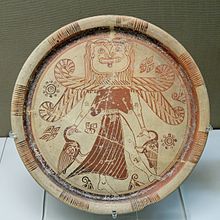Eastern Greek vase painting

The East Greek vase painting was a regional style of Greek vase painting . Despite the wealth of the region, the pottery was rather inconspicuous. The clay is reddish brown to pink and has many inclusions of mica . It was now recognized that there were many regional styles in Eastern Greece.
In Eastern Greek geometric vase painting , starting with the Middle Geometric period, a strong influence of Attic models was recognizable. This was felt early on, especially on Kos , although the shape of the lekyths also shows the influence of Cyprus. Larger vases were also found on Rhodes , including craters on high feet. Hatched meanders , triangles and rhombuses were characteristic of Eastern Greek vases . In the later period, water birds were also added. The Attic metope system was adopted, but quickly abandoned. Towards the end of the Geometric Period, vases were often given a white coating on which the drawings were applied.

Until the seventh century BC The geometric forms are passed on in the context of the subgeometric style. This subgeometric style lasted much longer here than in other Greek regions. Not until 650 BC He was replaced by an orientalizing animal style. It first appeared in the area around Miletus , a second center developed from around 625 BC. On Chios . The decoration scheme based on the animal style is named " Wild Goat Stile " after the most frequently shown animal . Until 600 BC Only outline drawings and recesses were used, then the use of incised drawings ( black-figure style ) also began , coming from northern Ionia . The animal frieze style was quite decorative, but offered little opportunity for further development. Regional styles emerged, especially in Ionia .
literature
- Thomas Mannack : Greek vase painting. An introduction. Theiss, Stuttgart 2002, ISBN 3-8062-1743-2 , pp. 81 f., 90-94, 134 f.
- Gerald P. Schaus: Geometric vase painting. In: The New Pauly (DNP). Volume 4, Metzler, Stuttgart 1998, ISBN 3-476-01474-6 , Sp. 935-938.
- Johannes Schwind: Orientalizing vase painting. In: The New Pauly (DNP). Volume 9, Metzler, Stuttgart 2000, ISBN 3-476-01479-7 , Sp. 23-26.
- Matthias Steinhart : Black-figure vase painting II. Outside table. In: The New Pauly (DNP). Volume 11, Metzler, Stuttgart 2001, ISBN 3-476-01481-9 , Sp. 276-281.